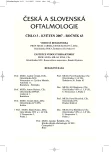Comparison of the Two Methods, LASIK and ICL in Mild and High Hyperopia Correction – Part One
Authors:
M. Horáčková; E. Vlková; V. Loukotová; Z. Hlinomazová
Authors‘ workplace:
Oftalmologická klinika LF MU a FN, Brno pracoviště Bohunice
přednosta prof. MUDr. Eva Vlková, CSc.
Published in:
Čes. a slov. Oftal., 63, 2007, No. 3, p. 143-153
Overview
The problems of hyperopia surgical correction are complicated. The most used methods are corneal laser treatments (PRK and LASIK), phakic intraocular lenses or clear lens extraction (CLE). The aim of the study was to evaluate and to compare long-term postoperative results of two types of refractive procedures in mild and high hyperopia correction: LASIK and ICL (phakic intraocular posterior chamber contact lens) implantation. The authors evaluated a group of 37 eyes of 20 patients; the average age was 36.3 years ± 11.8 (SD) and the followup period 28.1 months ± 10.2 (SD) after LASIK procedure, and group of 21 eyes of 13 patients; the average age was 28.6 years ± 6.1 (SD) and the follow-up period 30.4 months ± 20.9 (SD) after the ICL implantation. The final uncorrected (UCVA) and best-corrected visual acuity (BCVA) and postoperative refractive error (for far and near) and their development in time were compared. They found statistically significant improvement of the UCVA postoperatively comparing to the preoperative values in both methods (LASIK and ICL) (p < 0.05). Better UCVA was achieved by means of ICL implantation (p < 0.05). The BCVA improved after the ICL implantation only (p > 0.05). In hyperopic LASIK, the final BCVA worsened comparing to this before treatment (p > 0.05). The BCVA changes were not statistically significant. The authors also proved better final spherical refraction for far (p < 0.05 in the first and second year) and for the near as well (p < 0.05 in the first and second year) in the ICL method comparing to the hyperopic LASIK. The stableness of the postoperative refraction was better after the ICL implantation during the whole follow up period. In the laser treatment, the continuous regression of the postoperative refraction was evident. The final cylindrical refraction value was also lower in the ICL group (p > 0.05). The stableness of the postoperative cylindrical refraction was also higher in the ICL method during the whole follow up period. Conclusion: Comparing the intraocular procedure (ICL) to the laser method (LASIK), the ICL implantation demonstrates better final BCVA and UCVA and the postoperative refraction is more stable.
Key words:
hyperopia, LASIK, ICL
Labels
OphthalmologyArticle was published in
Czech and Slovak Ophthalmology

2007 Issue 3
Most read in this issue
- Ocular Manifestations in Turner’s Syndrome
- The Methods of Analysis of the Endothelial Microscopy
- Comparison of the Two Methods, LASIK and ICL in Mild and High Hyperopia Correction – Part One
- The Contribution of the Hematological Examination in Patients with Retinal Vein Occlusio
